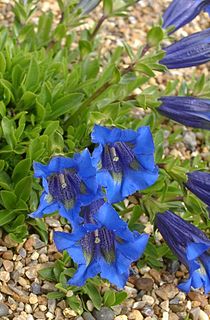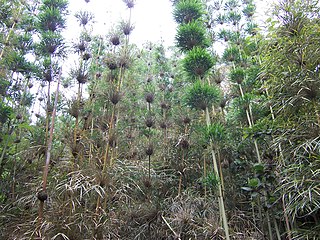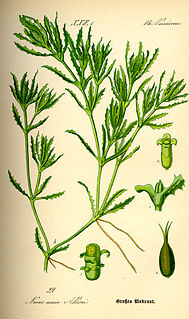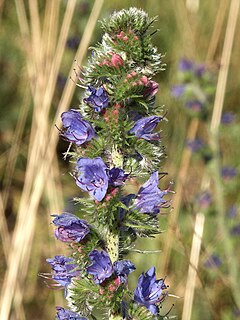
The Mascarene Islands or Mascarenes or Mascarenhas Archipelago is a group of islands in the Indian Ocean east of Madagascar consisting of the islands belonging to the Republic of Mauritius as well as the French department of Réunion. Their name derives from the Portuguese navigator Pedro Mascarenhas, who first visited them in April 1512. The islands share a common geologic origin in the volcanism of the Réunion hotspot beneath the Mascarene Plateau and form a distinct ecoregion with a unique flora and fauna.

GastoniaCommerson ex Lamarck is a formerly accepted genus of flowering plants in the ivy and ginseng family, Araliaceae. It had been known as an unnatural group, but was recognized as late as 2010, when its nine species were distributed to four different subgenera of the large genus Polyscias. Because the genus Gastonia is now obsolete, its species are herein referred to by their names in Polyscias.

Gentianaceae is a family of flowering plants of 103 genera and about 1600 species.

Olea is a genus of about 40 species in the family Oleaceae, native to warm temperate and tropical regions of the Middle East, southern Europe, Africa, southern Asia, and Australasia. They are evergreen trees and shrubs, with small, opposite, entire leaves. The fruit is a drupe. Leaves of Olea contain trichosclereids.

Foetidia is a genus of flowering plants first described as a genus in 1788. Most authors place the genus in the family Lecythidaceae, the sole genus in the subfamily Foetidioideae, but some prefer to treat it as a distinct family, the Foetidiaceae. It is native to eastern Africa and to various islands in the Indian Ocean.

Claoxylon is a flowering plant genus in the spurge family, Euphorbiaceae, comprising dioecious subshrubs to small trees. It was first described as a genus in 1824. The genus is distributed in paleotropical areas: Madagascar through South and Southeast Asia, Malesia to Melanesia, Hawaiʻi, and Australia. Half of the species are in Malesia. According to a molecular phylogenetic study by Wurdack, Hoffmann & Chase (2005), Claoxylon is sister to Erythrococca, and together they form the top of a Hennigian comb-like phylogeny.

Securinega is a genus of plants in the family Phyllanthaceae, first described as a genus in 1789. As presently conceived, the genus is native to Madagascar and the Mascarene Islands in the Indian Ocean. In the past, it was considered to be much more widespread, thus explaining the long list of species formerly included.
- Securinega antsingyensisLeandri - W Madagascar
- Securinega capuroniiLeandri - W Madagascar
- Securinega durissimaJ.F.Gmel. - Madagascar, Mauritius, Réunion, Rodrigues Island
- Securinega perrieriLeandri - W Madagascar
- Securinega seyrigiiLeandri - W Madagascar

Nastus is a genus of slender, erect, scrambling or climbing bamboos in the grass family. It is native to Southeast Asia, Papuasia, and certain islands in the Indian Ocean.

Louis-Marie Aubert du Petit-Thouars was an eminent French botanist known for his work collecting and describing orchids from the three islands of Madagascar, Mauritius and Réunion. The standard author abbreviation Thouars is used to indicate this person as the author when citing a botanical name.

Najas, the water-nymphs or naiads, is a genus of aquatic plants. It is cosmopolitan in distribution, first described for modern science by Linnaeus in 1753. Until 1997, it was rarely placed in the Hydrocharitaceae, and was often taken as constituting the family Najadaceae.

Boraginales is a valid taxonomic name at the rank of order for a group of flowering plants. It includes Boraginaceae and closely related asterid families. The Boraginales include about 125 genera, 2,700 species and its herbs, shrubs, trees and lianas (vines) have a worldwide distribution.

Sideroxylon is a genus of trees in the family Sapotaceae described as a genus by Linnaeus in 1753. They are collectively known as bully trees. The generic name is derived from the Greek words σιδηρος (sideros), meaning "iron", and ξύλον (xylon), meaning "wood."

The Mascarene martin or Mascarene swallow is a passerine bird in the swallow family that breeds in Madagascar and in the Mascarene Islands. The nominate subspecies occurs on Mauritius and Réunion and has never been found away from the Mascarene Islands, but the smaller Madagascan subspecies, P. b. madagascariensis, is migratory and has been recorded wintering in East Africa or wandering to other Indian Ocean islands.

Nuxia is a genus of plants in the family Stilbaceae described as a genus in 1791. It was formerly placed in the Loganiaceae and Buddlejaceae families.

Ochrosia is a genus of flowering plants, first described in 1789. It is in the family Apocynaceae, native to Southeast Asia, Australia, and various islands of the Indian and Pacific Oceans.
- Ochrosia ackeringae(Teijsm. & Binn.) Miq. – Indonesia, Philippines, Papuasia, Christmas Island
- Ochrosia acuminataTrimen ex Valeton - Sulawesi
- Ochrosia alyxioidesGuillaumin - Vanuatu
- Ochrosia apoensisElmer - Luzon, Mindanao
- Ochrosia balansae(Guillaumin) Baill. ex Guillaumin - New Caledonia
- Ochrosia basistaminaHendrian - Sulawesi
- Ochrosia bodenheimarumGuillaumin - Vallée de la Toutouta in New Caledonia
- Ochrosia borbonicaJ.F.Gmel. – Mauritius + Réunion; naturalized in Guangdong
- Ochrosia brevitubaBoiteau - New Caledonia
- Ochrosia brownii(Fosberg & Sachet) Lorence & Butaud - Nuku Hiva in Marquesas
- Ochrosia citrodoraK.Schum. & Lauterb. - New Guinea
- Ochrosia coccinea(Teijsm. & Binn.) Miq. - Maluku, Sulawesi, New Guinea, Solomon Islands; naturalized in Guangdong
- Ochrosia comptaK.Schum., Hōlei – Hawaii
- Ochrosia ellipticaLabill. – Lord Howe Island, Queensland, New Caledonia, Vanuatu, Nauru; naturalized in Guangdong + Taiwan
- Ochrosia fatuhivensisFosberg & Sachet – Fatu Hiva in Marquesas but extinct
- Ochrosia ficifolia(S.Moore) Markgr. - New Guinea
- Ochrosia glomerata(Blume) F.Muell. - Borneo, Sulawesi, Philippines, Maluku, New Guinea, Solomon Islands
- Ochrosia grandifloraBoit. – New Caledonia
- Ochrosia haleakalaeH.St.John, Hōlei – Maui + island of Hawaiʻi in Hawaiian Islands
- Ochrosia hexandraKoidz. - Kazan-retto
- Ochrosia inventorumL.Allorge – New Caledonia
- Ochrosia iwasakiana(Koidz.) Koidz. ex Masam.
- Ochrosia kauaiensisH.St.John, Hōlei – Kauaʻi in Hawaiian Islands
- †Ochrosia kilaueaensisH.St.John, Hōlei – island of Hawaiʻi in Hawaiian Islands, but extinct
- Ochrosia kilneriF.Muell. - Queensland
- Ochrosia lifuanaGuillaumin - Loyalty Islands + Isle of Pines in New Caledonia
- Ochrosia mariannensisA.DC. - Mariana Islands
- Ochrosia mianaBaill. ex Guillaumin – New Caledonia
- Ochrosia minima(Markgr.) Fosberg & Boiteau – Queensland, Papua New Guinea
- Ochrosia moorei(F.Muell.) F.Muell. ex Benth. – Queensland, New South Wales
- Ochrosia mulsantiiMontrouz. – New Caledonia
- Ochrosia nakaiana(Koidz.) Koidz. ex H.Hara - Ogasawara-shoto
- Ochrosia newellianaF.M.Bailey – Queensland
- Ochrosia novocaledonicaDäniker – New Caledonia
- Ochrosia oppositifolia(Lam.) K.Schum. - Seychelles, Chagos Islands, Sri Lanka, Maldive Islands, Andaman & Nicobar Islands, Thailand, Vietnam, W Malaysia, Indonesia, Papuasia, Samoa, Tonga, Tuvalu, Vanuatu, Wallis & Futuna, French Polynesia, Line Islands, Micronesia
- Ochrosia poweriF.M.Bailey - Queensland, New South Wales
- Ochrosia sciadophyllaMarkgr - Bismarck Archipelago, Solomon Islands
- Ochrosia sevenetiiBoiteau - New Guinea
- Ochrosia silvaticaDäniker – New Caledonia
- Ochrosia solomonensis(Merr. & L.M.Perry) Fosberg & Boiteau - Solomon Islands
- Ochrosia syncarpaMarkgr. - Bali, Lombok, Timor, Flores
- Ochrosia tahitensisLaness. ex Pichon – Tahiti
- Ochrosia tenimberensisMarkgr. - Tanimbar Islands
- Ochrosia nukuhivensisFosberg & Sachet = Rauvolfia nukuhivensis(Fosberg & Sachet) Lorence & Butaud
- Ochrosia sandwicensisA.DC. = Rauvolfia sandwicensisA.DC.
- Ochrosia tuberculata(Vahl) Pichon = Rauvolfia sandwicensisA.DC.

Nassauvia is a genus of flowering plants in the Nassauvia tribe within the sunflower family. It native to Argentina, Bolivia, Chile and the Falkland Islands.
Bremeria is a genus of flowering plants in the family Rubiaceae. It was described in 2005 to accommodate all the Indian Ocean species formerly placed in Mussaenda, except the widespread Mussaenda arcuata. The genus is indigenous to Madagascar, Mauritius and Réunion, and is found in humid to subhumid evergreen forests.
Danais is a genus of flowering plants in the family Rubiaceae. Most species are native to Madagascar; at least three others are distributed in Tanzania, Comoros, and the Mascarene Islands.
Declieuxia is a genus of flowering plants in the family Rubiaceae. The genus is found in tropical America.

Labourdonnaisia is a genus of plants in the family Sapotaceae found in tropical Asia, described as a genus in 1841.

















